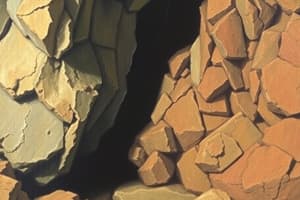Podcast
Questions and Answers
Which medium-grain size metamorphic rock is composed mostly of the same mineral as a sedimentary rock?
Which medium-grain size metamorphic rock is composed mostly of the same mineral as a sedimentary rock?
Marble
What is the texture of an igneous rock formed from magma that is cooled slowly deep underground?
What is the texture of an igneous rock formed from magma that is cooled slowly deep underground?
Nonvascular and coarse
Rock x is most likely what type of rock based on the photographs showing conglomerate?
Rock x is most likely what type of rock based on the photographs showing conglomerate?
Metamorphic
Use the chart to name the mineral that zincate will scratch.
Use the chart to name the mineral that zincate will scratch.
Which mineral is commonly used as 'Lead' in pencils?
Which mineral is commonly used as 'Lead' in pencils?
Which mineral can be found in the rock phyllite, sandstones, and granite?
Which mineral can be found in the rock phyllite, sandstones, and granite?
What physical property of muscovite mica can be observed?
What physical property of muscovite mica can be observed?
What is the texture of inorganic land-derived sedimentary rocks?
What is the texture of inorganic land-derived sedimentary rocks?
Which rock is classified as an evaporite?
Which rock is classified as an evaporite?
The crystal shape and type of cleavage of minerals are determined mainly by what?
The crystal shape and type of cleavage of minerals are determined mainly by what?
What geologic process causes the conversion of shale to gneiss?
What geologic process causes the conversion of shale to gneiss?
Peridot is a form of which mineral?
Peridot is a form of which mineral?
Which process leads directly to the formation of igneous rock?
Which process leads directly to the formation of igneous rock?
This rock composed of cemented pebbles and sand can be classified as what?
This rock composed of cemented pebbles and sand can be classified as what?
Which mineral will scratch fluorite, galena, and pyroxene?
Which mineral will scratch fluorite, galena, and pyroxene?
Obsidian's glassy texture indicates that it formed how?
Obsidian's glassy texture indicates that it formed how?
Which igneous rock has a vesicular texture and a felsic composition?
Which igneous rock has a vesicular texture and a felsic composition?
Which two processes lead directly to the formation of both breccia and conglomerate?
Which two processes lead directly to the formation of both breccia and conglomerate?
The basaltic bedrock of the oceanic crust is classified as what?
The basaltic bedrock of the oceanic crust is classified as what?
Identify metamorphic rock Y based on the diagram representing the rock cycle.
Identify metamorphic rock Y based on the diagram representing the rock cycle.
Which rock was originally found and sometimes contains fossilized plant impressions?
Which rock was originally found and sometimes contains fossilized plant impressions?
Most rock gypsum is formed by what process?
Most rock gypsum is formed by what process?
Which intrusive igneous rock could be composed of approximately 60% pyroxene, 25% plagioclase feldspar, 10% olivine, and 5% amphibole?
Which intrusive igneous rock could be composed of approximately 60% pyroxene, 25% plagioclase feldspar, 10% olivine, and 5% amphibole?
Which non-foliated rock forms only in a zone of contact metamorphism?
Which non-foliated rock forms only in a zone of contact metamorphism?
Flashcards are hidden until you start studying
Study Notes
Metamorphic Rocks
- Marble is a medium-grain size metamorphic rock composed primarily of the same mineral as a sedimentary rock.
- The conversion of shale to gneiss occurs through the process of metamorphism, which involves physical changes due to heat and pressure.
Igneous Rocks
- Nonvascular, coarse texture is characteristic of igneous rocks formed from slowly cooled magma deep underground.
- Obsidian has a glassy texture, indicating rapid formation on the Earth's surface.
- Pumice is identified as an igneous rock with a vesicular texture and felsic composition.
- Igneous rocks form through melting and solidification processes.
Sedimentary Rocks
- Clastic texture is typical of inorganic land-derived sedimentary rocks.
- Conglomerate and similar rocks are classified as clastic sedimentary rocks, formed through the cementation of pebbles and sand.
- Crystalline rock salt is classified as an evaporite, formed from the evaporation of water.
- Bituminous coal was originally formed from compacted organic material and sometimes contains fossilized plant impressions.
Minerals
- Graphite is commonly used as "Lead" in pencils.
- Quartz can be found in phyllite, sandstones, and granite.
- Muscovite mica displays cleavage as a key physical property.
- Olivine is a mineral that can scratch fluorite, galena, and pyroxene and is also the form of mineral peridot.
- Zincate can scratch calcite and celestine but not willemite.
Other Key Facts
- Gneiss is identified as a metamorphic rock within the rock cycle.
- Most rock gypsum is formed through the chemical precipitation of minerals from seawater.
- Gabbro is an intrusive igneous rock potentially composed of 60% pyroxene and other minerals.
- The crystal shape and type of cleavage in minerals are determined mainly by their composition and atomic arrangement.
- The processes of compaction and cementation lead to the formation of breccia and conglomerate.
Studying That Suits You
Use AI to generate personalized quizzes and flashcards to suit your learning preferences.




